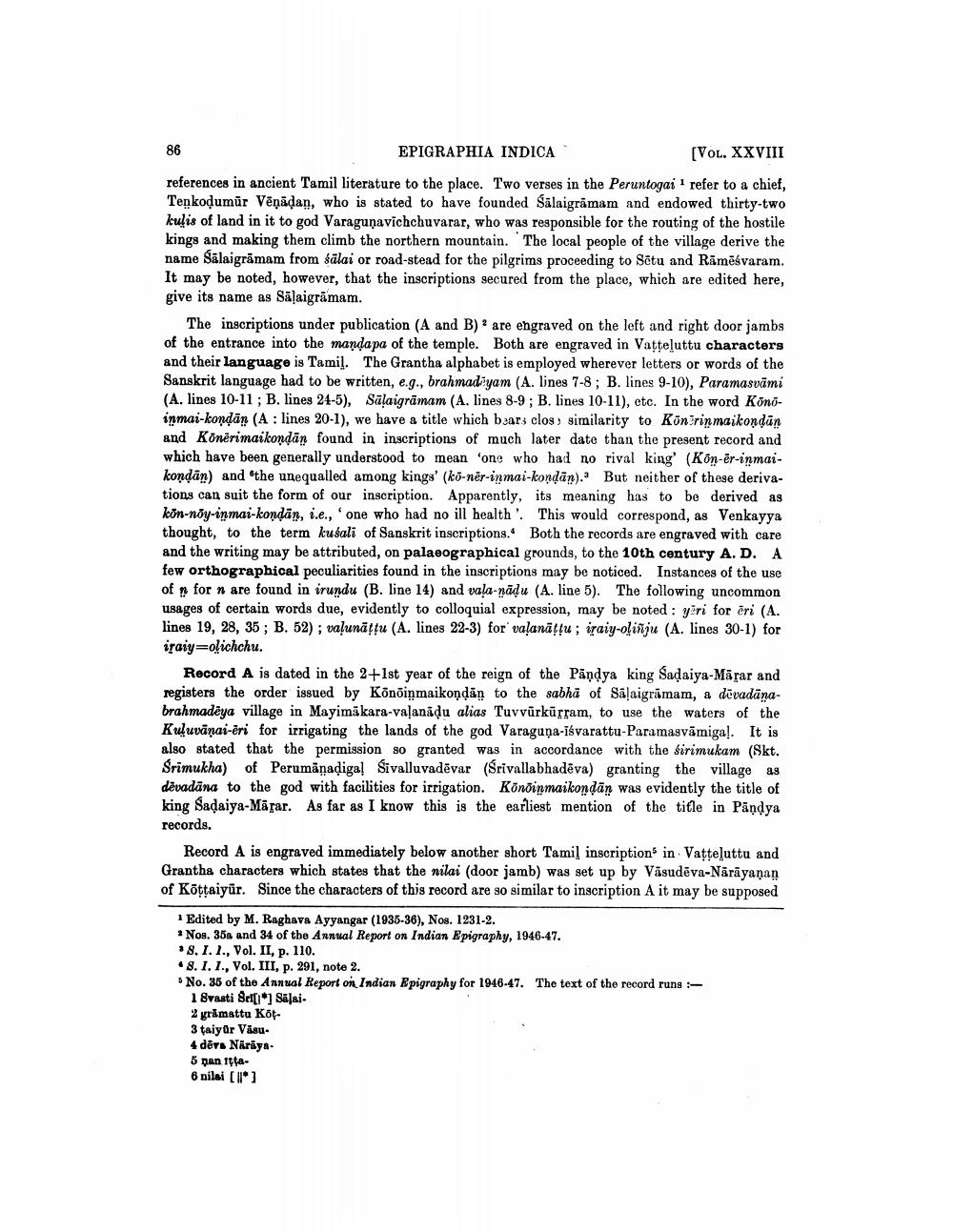________________
86
EPIGRAPHIA INDICA
(VOL. XXVIII
references in ancient Tamil literature to the place. Two verses in the Peruntogai refer to a chief, Tenkodumūr Vēņādan, who is stated to have founded Sälaigrāmam and endowed thirty-two kulis of land in it to god Varagunavichchuvarar, who was responsible for the routing of the hostile kings and making them climb the northern mountain. The local people of the village derive the name Sālaigrāmam from sälai or road-stead for the pilgrims proceeding to Sētu and Rāmēsvaram. It may be noted, however, that the inscriptions secured from the place, which are edited here, give its name as Sāļaigrāmam.
The inscriptions under publication (A and B) 2 are engraved on the left and right door jambs of the entrance into the mandapa of the temple. Both are engraved in Vatteluttu characters and their language is Tamil. The Grantha alphabet is employed wherever letters or words of the Sanskrit language had to be written, e.g., brahmadiyam (A. lines 7-8; B. lines 9-10), Paramasvāmi (A. lines 10-11 ; B. lines 24-5), Sālaigrāmam (A. lines 8-9; B. lines 10-11), etc. In the word Konoinmai-kondān (A: lines 20-1), we have a title which bear: clos) similarity to Konirinmaikondan and Konėrimaikondan found in inscriptions of much later date than the present record and which have been generally understood to mean 'one who had no rival king' (Kon-er-inmaikondān) and the unequalled among kings' (ko-ner-inmai-kondān). But neither of these derivations can suit the form of our inscription. Apparently, its meaning has to be derived as kon-noy-inmai-kondām, i.e., one who had no ill health'. This would correspond, as Venkayya thought, to the term kusali of Sanskrit inscriptions. Both the records are engraved with care and the writing may be attributed, on palaeographical grounds, to the 10th century A. D. A few orthographical peculiarities found in the inscriptions may be noticed. Instances of the use of for n are found in irundu (B. line 14) and vala-nādu (A. line 5). The following uncommon usages of certain words due, evidently to colloquial expression, may be noted : yiri for ēri (A. lines 19, 28, 35; B. 52); vaľunāffu (A. lines 22-3) for valanāļļu; iraiy-olinju (A. lines 30-1) for iraiy=olichchu.
Record A is dated in the 2+1st year of the reign of the Pāņdya king Sadaiya-Mārar and registers the order issued by Könõiņmaikondan to the sabha of Sälaigramam, a dövadānabrahmadēya village in Mayimakara-vaļanādu alias Tuvvürkūrram, to use the waters of the Kuluvānai-eri for irrigating the lands of the god Varaguņa-īśvarattu-Paramasvāmiga!. It is also stated that the permission so granted was in accordance with the sirimukam (Skt. Srimukha) of Perumāņadiga! Sivalluvadēvar (Srivallabhadēva) granting the village 23 dēvadāna to the god with facilities for irrigation. Könõinmaikondān was evidently the title of king Sadaiya-Mäsar. As far as I know this is the earliest mention of the title in Pāņdya records.
Record A is engraved immediately below another short Tamil inscription in Vaţteluttu and Grantha characters which states that the nilai (door jamb) was set up by Väsudēva-Nārāyanan of Kottaiyür. Since the characters of this record are so similar to inscription A it may be supposed
Edited by M. Raghava Ayyangar (1935-36), Nos. 1231-2. * Nos. 358 and 34 of the Annual Report on Indian Epigraphy, 1946-47. *8.1.1., Vol. II, p. 110. .8.1.1., Vol. III, p. 291, note 2. * No. 35 of the Annual Report on Indian Epigraphy for 1946-47. The text of the record runs -
1 Svasti set[*] Sālai. 2 gråmattu Kot3 taiyur Vasu. 4 déns Naraya 5 Dan itta6 nilai (1)




